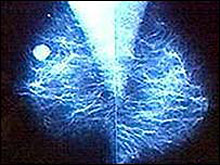 |
 |
 |
 Health & Beauty | July 2005 Health & Beauty | July 2005  
Benign Breast Lumps Cancer Link
 BBC BBC


| | Breast lesions can be picked up by scans. |
Women who have certain types of benign breast disease have far a higher risk for breast cancer, say US researchers. Identifying and closely monitoring these women could help save lives, the Mayo Clinic team believe.

Although most non-cancerous breast lumps do not increase future risk of breast cancer, they found faster growing and more abnormal types did.

This finding, in the New England Journal of Medicine, held even if there was no family history of breast cancer.

Benign breast lumps

The lifetime risk for breast cancer in women is one in nine, with over 38,000 new cases each year.

The first sign may be a lump in the breast.

However, often the lump is actually not cancerous, which doctors had thought meant there was no increased future risk of a malignant tumour.

The only way to tell for sure whether or not a lump is cancerous is to take a sample of cells, called a biopsy, and examine this in the lab.

In the Mayo Clinic study, the researchers looked at biopsy samples from 9,087 women aged 18 to 85 with benign breast lumps that had been taken at their clinic between 1967 and 1991.

They asked a pathologist who did not know the diagnoses of the women to assign the lesions to one of three categories - proliferative (faster growing), non-proliferative and atypical (abnormal).

The risks

The researchers then checked how many of the women went on to develop breast cancer - 707 cancers were found over a period of 15 years.

With this information they were able to check at whether the category of the benign lesion examined was linked to future cancer risk.

Women with proliferative or atypical benign tumour samples were more likely to have developed breast cancer than those who had non-proliferative benign breast lumps.

According to the study, six out of 100 women with a non-proliferative benign breast lump would develop cancer within 15 years, compared to 10 out of 100 women with proliferative benign breast lumps and 19 out of 100 women with atypical benign breast lumps.

For women of the same age, in general the risk of developing breast cancer over 15 years is five per 100.

Advice

Lead researcher Dr Lynn Hartmann suggested women who have a breast lump biopsy that is benign might want to discuss the possibility of additional risks with their doctors.

"Our goal is to do a better job of risk prediction for women," she said.

Emma Pennery, nurse consultant at Breast Cancer Care, said: "It is important for women of all ages to be breast aware. This means knowing how your breasts look and feel normally."

"If someone notices unusual changes in the breast, it is important that they see their GP."

Professor Charles Coombes at Cancer Research UK said: "This is an important study which demonstrates that patients who have had a breast operation for benign breast disease showing abnormal cells should be closely monitored and be on long-term follow-up."

"Patients who are uncertain of their diagnosis should ask their doctors for confirmation. Patients with a strong family history of breast cancer should continue to be followed up closely, but especially if they have had a biopsy for benign breast disease." | 
 | |
 |



